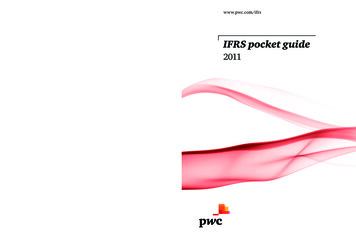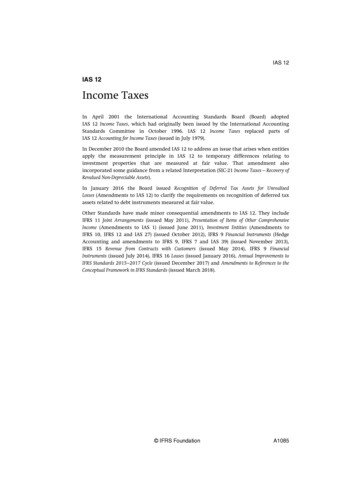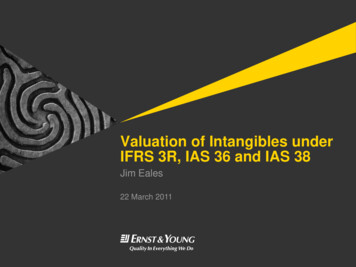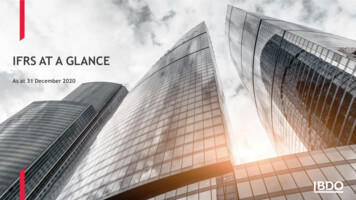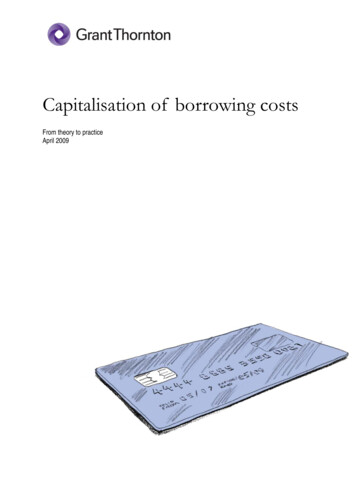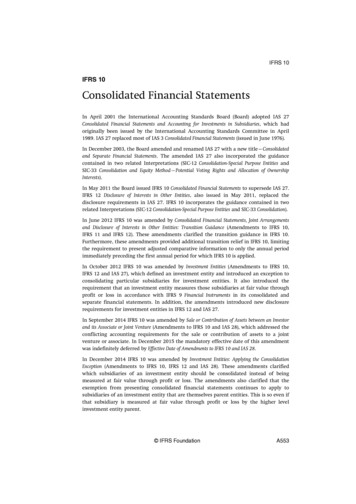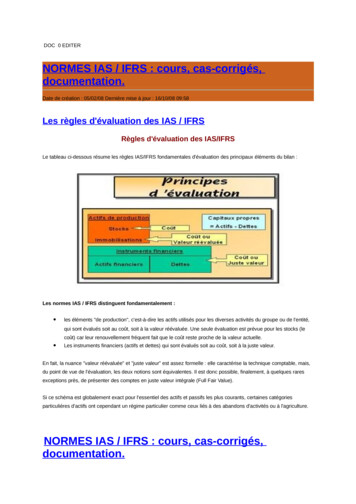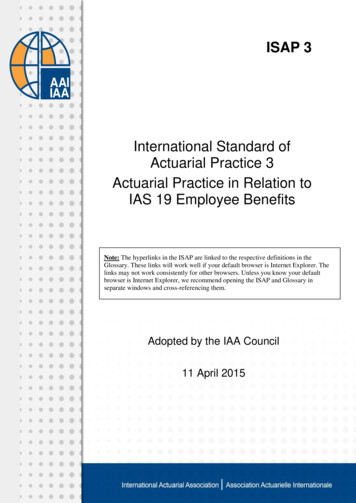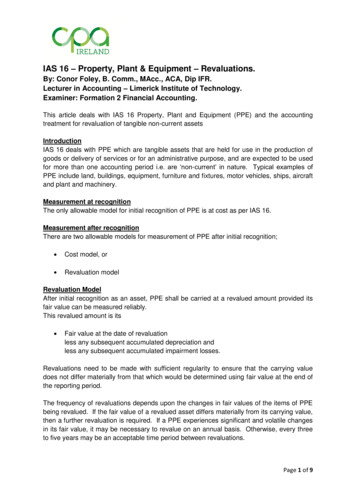
Transcription
IAS 16 – Property, Plant & Equipment – Revaluations.By: Conor Foley, B. Comm., MAcc., ACA, Dip IFR.Lecturer in Accounting – Limerick Institute of Technology.Examiner: Formation 2 Financial Accounting.This article deals with IAS 16 Property, Plant and Equipment (PPE) and the accountingtreatment for revaluation of tangible non-current assetsIntroductionIAS 16 deals with PPE which are tangible assets that are held for use in the production ofgoods or delivery of services or for an administrative purpose, and are expected to be usedfor more than one accounting period i.e. are ‘non-current’ in nature. Typical examples ofPPE include land, buildings, equipment, furniture and fixtures, motor vehicles, ships, aircraftand plant and machinery.Measurement at recognitionThe only allowable model for initial recognition of PPE is at cost as per IAS 16.Measurement after recognitionThere are two allowable models for measurement of PPE after initial recognition;Cost model, orRevaluation modelRevaluation ModelAfter initial recognition as an asset, PPE shall be carried at a revalued amount provided itsfair value can be measured reliably.This revalued amount is itsFair value at the date of revaluationless any subsequent accumulated depreciation andless any subsequent accumulated impairment losses.Revaluations need to be made with sufficient regularity to ensure that the carrying valuedoes not differ materially from that which would be determined using fair value at the end ofthe reporting period.The frequency of revaluations depends upon the changes in fair values of the items of PPEbeing revalued. If the fair value of a revalued asset differs materially from its carrying value,then a further revaluation is required. If a PPE experiences significant and volatile changesin its fair value, it may be necessary to revalue on an annual basis. Otherwise, every threeto five years may be an acceptable time period between revaluations.Page 1 of 9
For example, if we take the property market in Ireland over the last ten years, the periodbetween 2001 and 2007 was where buildings, in general, experienced high increases in theirmarket value due to low interest rates, ready availability of credit and confidence in thesector. As a result, property prices increased sizeably in value annually and therefore, if acompany was using the revaluation method in relation to buildings, there may have been anecessity to revalue the buildings annually, using a professionally qualified valuer, to ensurethat the company complied with IAS 16. From 2007, property prices in Ireland haveplummeted and again, a company may have to revalue annually due to the sizeabledecreases year-on-year in property prices so as to comply with the standard.When an item of PPE is revalued, there are two methods of dealing with accumulateddepreciation with the most commonly used method being the following whereby;Accumulated depreciation is eliminated against the gross carrying value of the assetand the net amount restated to the revalued amount of the asset.ExampleA building was purchased on the 1st January 2006 at a cost of 100 million. It is beingdepreciated over 50 years. The company decided to use the revaluation model for valuingbuildings in 2011 and at the 31st December 2011, the building was valued at 80 million by aprofessional valuer.SolutionBy the 31st December 2011, the asset has been depreciated for 6 years. This meansthat the accumulated depreciation is 12 million ( 100 million / 50 years * 6 years).Per IAS16, this accumulated depreciation is netted against the cost; Cost100 millionless Accumulated Depreciation12 millionCarrying Value88 millionThis carrying value of 88 million is compared against the revalued amount of 80million and a revaluation loss of 8 million needs to be accounted for.Revaluation & Class of AssetsIf PPE is revalued, then the entire class of PPE to which that asset belongs also needs to berevalued i.e. if a company owns 5 buildings which it uses for storing grain and they decide torevalue 1 building, then per IAS 16, all buildings have to be revalued as they belong to thesame class or category under PPE i.e. they are of a similar nature and use in the company’soperationsRevaluation GainsIf an asset’s carrying amount is increased as a result of a revaluation, the increase shall berecognised in the Other Comprehensive Income (OCI) section of the Statement ofComprehensive Income (SOCI) and included in the Equity section of the Statement ofFinancial Position (SOFP) under the heading of a revaluation surplus. The double entry forthis is shown on the following page:Page 2 of 9
Dr.Cr.PPE – Non-Current Assets (SOFP) XOCI (SOCI)XExampleA company revalued their land from 200,000 to 300,000. The profit for the year fromnormal day to day activities of the company is 350,000 and at the start of the year therewas a revaluation surplus of 75,000. The retained earnings at the start of the yearamounted to 120,000.The ledger entry and the extracts from the SOCI and SOFP for this revaluation are shownbelow:SolutionThe ledger entry is as follows:Dr.Cr. 100,000PPE (SOFP)OCI (SOCI)100,000Extract from SOCIProfit for the YearOther Comprehensive IncomeRevaluation Gain from LandTotal Comprehensive Income for the YearExtract from SOFPNon-Current AssetsPPETotal Non-Current AssetsEquityRetained EarningsRevaluation SurplusTotal Equity 350,000100,000450,000300,000300,000(120,000 350,000)(75,000 100,000)470,000175,000645,000Note that the Total Comprehensive Income amount of 450,000 is taken to the Equitysection of the SOFP but 350,000 of it goes to retained earnings and the 100,000revaluation gain is added to the revaluation surplus.In relation to revaluation gains on PPE, an increase or gain shall be recognised in profit orloss to the extent that it reverses a revaluation decrease of the same asset previouslyrecognised in profit or loss.Page 3 of 9
ExampleA company revalued their land from 200,000 to 300,000. Previously, the same land hadbeen revalued downwards from 260,000 to 200,000 creating a revaluation loss of 60,000which was taken to profit or loss as there was no revaluation surplus as this was the firsttime the asset had been revalued. The profit for this year from normal day to day activitiesof the company before revaluation is 300,000 and at the start of the year the retainedearnings amounted to 150,000.The ledger entry and the extracts from the SOCI and SOFP for this transaction are shownbelow:SolutionThe ledger entry is as follows:Dr.Cr.Cr.PPE (SOFP)Profit or Loss (SOCI)OCI (SOCI)Extract from SOCIProfit for the YearRevaluation GainProfit for the Year 60,00040,000300,00060,000360,000Other Comprehensive IncomeRevaluation Gain from LandTotal Comprehensive Income for the YearExtract from SOFPNon-Current AssetsPPETotal Non-Current AssetsEquityRetained EarningsRevaluation SurplusTotal Equity 100,00040,000400,000300,000300,000(150,000 360,000)510,00040,000550,000Page 4 of 9
Revaluation LossesIf an asset’s carrying amount is decreased as a result of a revaluation, the decrease shall berecognised in profit or loss. However, the decrease shall be recognised in OCI to the extentof any credit balance existing in the revaluation surplus in respect of that asset. Thedecrease recognised in OCI reduces the amount accumulated in equity under the heading ofrevaluation surplus. The double entry for this is as follows:Dr.OCI (SOCI) (If Revaluation Surplus already in Accounts) XCr.PPE – Non-Current Asset (SOFP)XUp to the maximum of a revaluation surplus and the balance being accounted asfollows:Dr.Cr.Profit or Loss (SOCI)PPE – Non-Current Assets (SOFP)XXExampleA company revalued their land from 500,000 to 400,000. The profit for the year fromnormal day to day activities of the company is 300,000 and at the start of the year therewas a revaluation surplus of 75,000. The retained earnings at the start of the yearamounted to 180,000.The ledger entry and the extracts from the SOCI and SOFP for this transaction follow:SolutionThe ledger entry is as follows:Dr.Dr.Cr.OCI (SOCI)Profit of Loss (SOCI)PPE (SOFP)Extract from SOCIProfit for the YearRevaluation LossProfit for the YearOther Comprehensive IncomeRevaluation LossTotal Comprehensive Income for the Year 75,00025,000 100,000300,000(25,000)275,000(75,000)200,000Page 5 of 9
Extract from SOFPNon-Current AssetsPPETotal Non-Current AssetsEquityRetained EarningsRevaluation SurplusTotal Equity 400,000400,000(180,000 275,000)(75,000 - 75,000)455,0000455,000Note that the Total Comprehensive Income amount of 200,000 is taken to the Equitysection of the SOFP but 275,000 of it goes to retained earnings and the 75,000revaluation loss is taken from the revaluation surplus brought forward.The revaluation surplus included in equity in respect of PPE may be transferred directly toretained earnings when the asset is derecognised. This may involve transferring the wholeof the surplus when the asset is retired or disposed of. Alternatively, some of the surplusmay be transferred as the asset is used by an entity. In such a case, the amount of thesurplus transferred would be the difference between depreciation based on the revaluedcarrying amount of the asset and depreciation based on the asset’s original cost.Transfers from revaluation surplus to retained earnings are not made through profit or lossbut instead through the statement of changes in equity.Example of the Impact of a Revaluation at the Start or End of a YearThe following is an extract from the trial balance of Listra Limited for the year ended 31stDecember 2010 Land400,000Building at Cost1,600,000Accumulated Depreciation – Buildings800,000stRetained Earnings at 1 January 2010200,000Revaluation Surplus150,000Profit for the year before any adjustments400,000Notes:1. Depreciation to date on buildings has been on a cost basis and has been at the rateof 5% of cost on a straight line basis.2. Land is not being depreciatedPage 6 of 9
Question:Prepare a working for PPE and the relevant extracts from the published accounts for the2010 financial year based on the following requirementsa) The land and buildings were revalued at the 1st January 2010 at 1,450,000 of whichland amounted to 450,000 orb) The land and buildings were revalued at the 31st December 2010 at 1,450,000 ofwhich land amounted to 450,000.Please note that the original life of the buildings has not changed as a result of therevaluation and the residual value of the buildings is estimated at the date of revaluationto be 400,000SolutionRevaluation of Land & Buildings at the 1st January 2010PPE WorkingCostAccumulated DepreciationCarrying Value at 1st January 2010Revaluation GainCarrying Value after revaluationDepreciation – Buildings (Note 1)Carrying Value at 31st December 2010Land 400,0000400,00050,000450,000450,000Buildings 40,000Total )1,390,000Note 1 – Depreciation of BuildingsFormula for Depreciation of Assets after Revaluation is as follows:Revalued Amount- Residual ValueRemaining Useful LifeAt this stage, the Revalued Amount 1,000,000, the Residual Value 400,000 but theremaining useful life has to be calculated.What was the expected useful life of the buildings?Based on the information in the question, the asset would have been depreciated at the rateof 5% each year. Therefore, the asset, at this rate of depreciation, would have beendepreciated over 20 years (100% / 5% each year) and consequently, the expected useful lifeof the building is 20 years.How many years of the useful life have been used before revaluation?If the asset was being depreciated at the rate of 5% per year, then the depreciation eachyear would be 80,000 i.e. 1,600,000 x 5%. Given that the accumulated depreciation atthe start of the year is 800,000, the asset must have been depreciated for 10 years by the1st January 2010 ( 800,000\ 80,000 10 Years). The question tells us that the originaluseful life does not change as a result of the revaluation. Therefore, the remaining usefullife is 10 years (20 years original useful life – 10 years of the buildings being depreciated).Page 7 of 9
The depreciation of the revalued buildings can now be calculated as follows:Revalued AmountResidual ValueRemaining Useful Life 1,000,000 - 400,000 10 Years 600,00010 Years 60,000 depreciation per yearThe ledger entry is as follows: 250,000Dr.Cr.PPE (SOFP)OCI (SOCI)Dr.Cr.Depreciation Expense (SOCI)PPE (SOFP)250,000Extract from SOCIProfit for the YearDepreciation – BuildingsProfit for the YearOther Comprehensive IncomeRevaluation Gain from PPETotal Comprehensive Income for the YearExtract from SOFPNon-Current AssetsPPETotal Non-Current AssetsEquityRetained EarningsRevaluation SurplusTotal Equity 390,0001,390,000(200,000 340,000)(150,000 250,000)540,000400,000940,000Page 8 of 9
Revaluation of Land & Buildings at the 31st December 2010PPE WorkingCostAccumulated DepreciationCarrying Value at 1st January 2010Depreciation – Buildings (Note 1)Carrying Value after depreciationRevaluation GainCarrying Value at 31st December 2010Land 400,0000400,000400,00050,000450,000Buildings 00,000Total 01,450,000Note 1 – Depreciation of BuildingsIf the asset was being depreciated at the rate of 5% per year, and the revaluation takesplace at the end of the year, i.e. the asset should be depreciated for a full year at the costbasis rate of depreciation, and therefore, the depreciation for 2010 would be 80,000 i.e. 1,600,000 x 5%.The ledger entry is as follows: 330,000Dr.Cr.PPE (SOFP)OCI (SOCI)Dr.Cr.Depreciation Expense (SOCI)PPE (SOFP)330,000Extract from SOCIProfit for the YearDepreciation – BuildingsProfit for the YearOther Comprehensive IncomeRevaluation Gain from PPETotal Comprehensive Income for the YearExtract from SOFPNon-Current AssetsPPETotal Non-Current AssetsEquityRetained EarningsRevaluation SurplusTotal Equity 450,0001,450,000(200,000 320,000)(150,000 330,000)520,000480,0001,000,000Page 9 of 9
Page 1 of 9 IAS 16 - Property, Plant & Equipment - Revaluations. By: Conor Foley, B. Comm., MAcc., ACA, Dip IFR. Lecturer in Accounting - Limerick Institute of Technology. Examiner: Formation 2 Financial Accounting. This article deals with IAS 16 Property, Plant and Equipment (PPE) and the accounting
